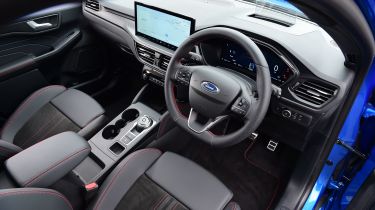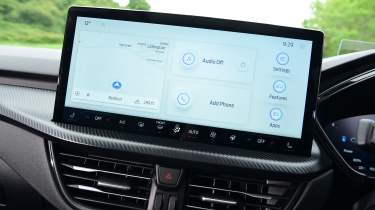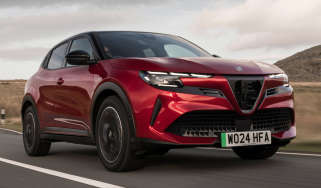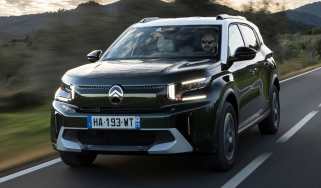Ford Kuga review - Interior & comfort
"Ergonomic if a little unimaginative, the Ford Kuga’s interior shares much with other Fords"
The third-generation Ford Kuga made its debut back in 2019, and while that’s not too long ago in real terms, it allowed newer rivals to enter the scene with much more hi-tech and visually appealing designs. Step forward the 2024 facelift, which aims to redress the balance with a new look and interior tech.
Unfortunately it still feels as though the Ford Kuga falls behind rivals because the finish and feel looks a bit outdated and there’s not as much flair as the interiors of the Peugeot 3008 and Kia Sportage. Much of the Kuga’s interior is shared with other Fords such as the Focus, although top-spec models get luxuries like Alcantara upholstery. Even when this is fitted, though, the Kuga doesn’t feel as plush as rivals. The upside to some of the harder plastics is that the Kuga should at least be durable enough for family life, it’s just a shame it comes at the expense of visual appeal.
Ford Kuga infotainment and navigation
No matter which variant of the Ford Kuga you opt for, all now come as standard with a new touchscreen featuring Ford’s SYNC 4 infotainment software. It’s easy to use and more responsive to your inputs than the old screen and comes as standard with DAB radio and sat-nav, as well as Apple CarPlay and Android Auto if you’d rather utilise your phone’s software. There’s also a digital driver’s display which looks sharp and the light lettering on a dark background doesn’t cause eye strain at night.
In the pre-facelift Kuga, we liked the fact Ford steered clear of integrating several important functions into the touchscreen; the stereo volume and climate controls were operated via physical knobs and dials, which are much easier to handle when on the move than a slippery screen. It’s a shame this is no longer the case, because many of the car’s functions have now been relegated to the touch screen which makes them harder to tweak on the move.
Equipment
A slimmed-down range of trims kicks off with Titanium, getting a 13-inch touchscreen, all-round parking sensors, 17-inch alloy wheels and even a heated windscreen to clear it quickly on frosty mornings. ST-Line is a worthwhile upgrade, ushering in handy features like a 360-degree camera view, powered hatchback and adaptive cruise control, while it also gets a sporty makeover.
Active doesn’t offer quite the same jump, but increases the Kuga’s ride height slightly and brings black exterior trim along with microsuede seat upholstery. ST-Line X bolsters things even further with heated rear seats and a heated steering wheel, along with a panoramic glass roof.
Options
It’s possible to add a Driver’s Assistance Pack to the entry-level trim if you’d rather have a 360-degree camera view for easier parking. We’d recommend specifying the Technology Pack, which adds features like LED Matrix headlights that adapt to the traffic and conditions, along with a head-up display that can provide critical driving information without needing to look away from the road – these cars also get a slim LED light bar that runs between the lights above the grille. Specifying larger alloy wheels can be very expensive – while Active models come with 18-inch alloys as standard, it will cost you a hefty £1,200 to add 20-inch wheels, while the 19-inch option is £600.












